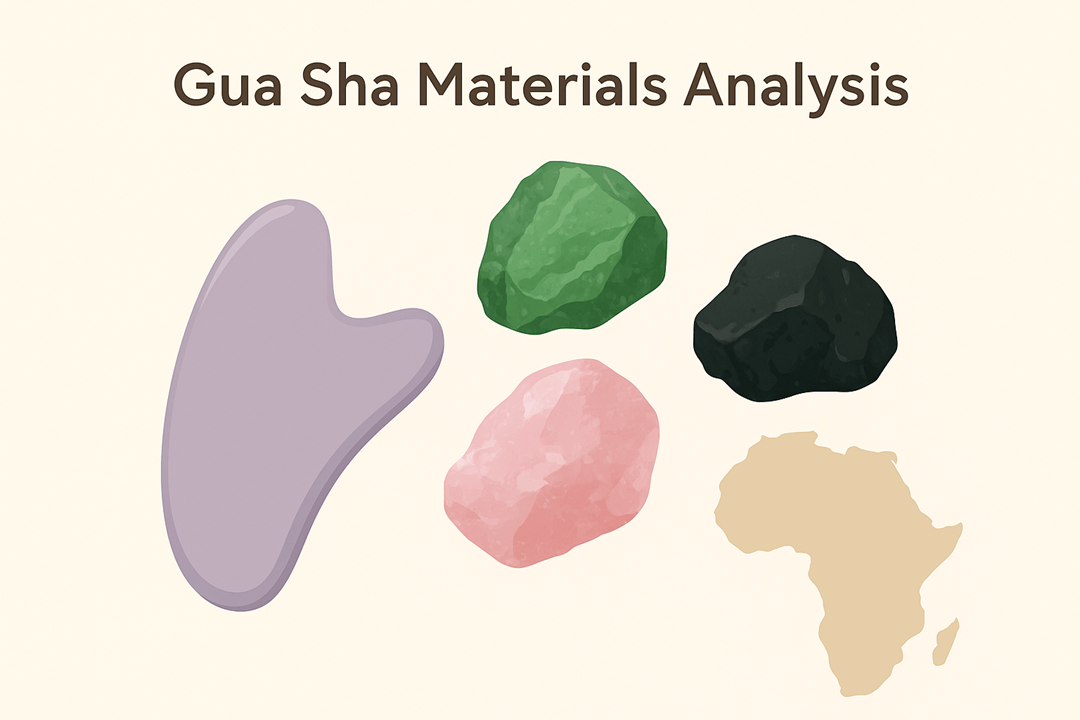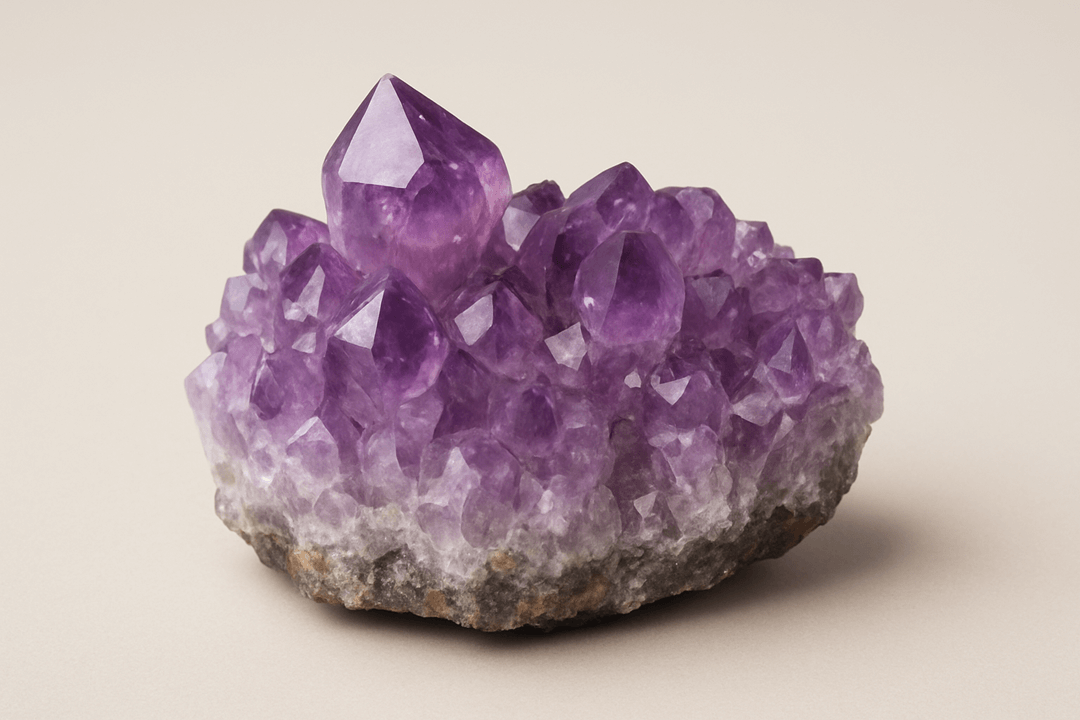
In recent years, with the continuous expansion of the Gua Sha market and a surge in demand, the market trends and price fluctuations of Gua Sha materials have become a key focus for many Gua Sha manufacturer. Low prices mean a sharp reduction in production costs, while securing large quantities of raw materials ensures a stable supply. Both are directly related to the manufacturer’s specific interests.
However, for raw materials such as crystal and jade, their market supply is directly affected by mining volume, resulting in drastic price fluctuations. For example, the current amethyst raw material, affected by mining volume, has led to a sharp increase in cost and a shortage of supply.
Today, we will analyze the market trends of amethyst raw materials, starting with amethyst raw materials and branching out to other crystal and jade materials.
1. Why is Amethyst Gua Sha so Hard to Come By?

Amethyst in China is primarily divided into two types: “dog-tooth amethyst” (the raw material contains white banding), and “flower amethyst” (which lacks the white banding). Originally, the price of “dog-tooth amethyst” was slightly lower than that of “flower amethyst,” but with increasing material scarcity, the prices of both have risen sharply, and are now roughly on par.
Most of the world’s amethyst is mined in regions such as South Africa, Brazil, and Uruguay. Amethyst is inherently scarcer than crystals like rose quartz. In addition to recent years of heavy mining, several major mines have been depleted, and new mines have yet to be discovered. This has led to an extreme shortage of amethyst in the raw material market. Not only is the quantity scarce, but the quality is also subpar. This situation has persisted for nearly a year and shows no signs of improvement.
Besides the scarcity of raw material, another major factor is the structure of amethyst’s crystals. Amethyst cannot be produced in the form of large crystals like rose quartz, which can weigh several tons. Instead, it typically weighs around one or two kilograms. This size makes it difficult to create gua sha tools. Most raw amethyst is not large enough for this purpose, and can only be made into small carvings.
Future Trend: Alternative materials (dyed crystal/synthetic amethyst) may emerge, but genuine amethyst will remain the mainstream in the high-end market.
2. Analysis of Other Crystal/Jade Gua Sha Materials
1. Mining situation:
- Jade and Rose Quartz
- The supply chain is relatively stable. Jade primarily comes from mining areas in China, Brazil, and India. Rose quartz, like amethyst, is primarily sourced from Africa and Brazil.
- Overall reserves are relatively abundant, and current mining output remains relatively stable. A sharp drop in production is unlikely in the near term (except under exceptional circumstances). Therefore, the overall market supply and demand is balanced, and prices are stable.
- Other Crystals (Clear Crystal, Citrine, etc.)
- Raw crystals are primarily sourced from Brazil, South Africa, Madagascar, Yunnan, China, and other regions.
- Due to the difficulty of mining in some locations, transportation and processing also affect costs. However, overall prices are currently stable and are unlikely to experience significant fluctuations for the time being.
2. Analysis of the Market Sales Situation of Gua Sha materials:
- Green Jade
- Market Positioning: A traditional, classic gua sha material, it enjoys the highest recognition among consumers, particularly in China.
- Sales Characteristics: Stable demand, often used in mid- to low-end products. Green Jade utilizes materials from the serpentine jade family, rather than traditional jade, such as Hetian jade, resulting in a significantly lower price.
- Market Trend: Prices are generally stable. Due to a mature supply chain and large mining volumes, short-term price fluctuations are unlikely.
- Rose Quartz
- Market Positioning: Primarily focused on beauty benefits. Its beautiful appearance and affordable price make it popular among female consumers. It’s currently a hot-selling material in the Gua Sha market.
- Sales Characteristics: It performs well in the European and American markets, often being bundled with the concepts of “self-love” and “beauty energy.”
- Market Trends: With steady demand growth, wholesale prices for Gua Sha remain stable, even declining slightly.
- Stainless Steel Material
- Market Positioning: Metal gua sha blades, such as stainless steel, titanium alloy, and zinc alloy, are gradually gaining acceptance among Western users due to their cool feel, durability, and easy cleanability.
- Sales Characteristics: Prices generally range from $5–20 per piece, placing them in the mid- to high-end segment compared to natural stone. Some medical aesthetic brands offer medical stainless steel gua sha blades for over $50.
- Market Trends: On platforms like Amazon and Etsy, branded metal gua sha blades are often the preferred choice for aestheticians.
3. Challenges Faced By Supply Chain and Gua Sha Manufacturer
- Raw material shortages and price fluctuations
In recent years, with the booming Gua Sha market, a large amount of raw stones have been mined. However, raw stone resources are limited, and some precious raw stones are at risk of depletion, while new resources are unlikely to be discovered in a short period of time. This has led to a large shortage of raw materials, with amethyst being a typical example. This situation has forced Gua Sha manufacturer to lock in resources in advance, resulting in increased financial pressure.
- Environmental protection and mining policies are becoming stricter.
The international market is increasingly demanding sustainable mining and environmental certification, and some supply chains are facing compliance challenges. Controls on the export of rough diamonds will also become increasingly stringent.
- Manufacturing Process Upgrades
The high-end market has higher requirements for the polishing, design, and branding of Gua Sha blades. While this will drive the upgrading of manufacturing processes in the industry to a certain extent, it also brings more challenges to Gua Sha manufacturer.
The material market for Gua Sha tools is no longer simply a matter of raw material selection; it is a comprehensive reflection of supply chains, environmental policies, and global consumer trends. Given the scarcity of amethyst resources, Gua Sha manufacturer must not only seize opportunities in the high-end market but also actively explore alternative materials and innovative products to maintain their advantages in the fierce competition of the future.






